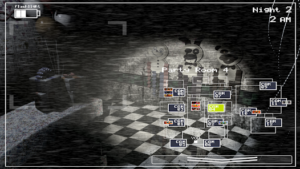Fear is a complex emotion that has intrigued psychologists for centuries. It evokes intense reactions and can be both paralyzing and exhilarating simultaneously. In recent years, video games have become an immersive medium to explore human emotions, with “Very Little Nightmares” being no exception. This dark puzzle platformer delves into the depths of fear, unravelling psychological intricacies that captivate players throughout their eerie journey.
Understanding Fear:
Before diving into the psychology behind fear in “Very Little Nightmares,” it’s crucial to grasp its fundamental aspects. Fear is an innate survival mechanism triggered by perceived threats or danger. When confronted with fearful stimuli, our bodies release stress hormones like adrenaline, preparing us for fight-or-flight responses.
The Role of Atmosphere:
One significant aspect contributing to fear in this game lies within its atmospheric design. From dimly lit rooms to haunting soundscapes and unsettling visuals, every element works together seamlessly to create a sense of unease and vulnerability among players.
Environmental Cues:
In “Very Little Nightmares,” environmental cues heighten fear levels. Claustrophobic spaces filled with grotesque creatures instil a feeling of entrapment, while dilapidated surroundings evoke abandonment anxiety – all intensifying player immersion through emotional triggers associated with real-life fears.
Uncertainty as Fuel for Fear:
Another psychological component exploited effectively by this game is uncertainty or unpredictability—both powerful catalysts for inducing fear responses within individuals’ minds.
The absence of clear objectives or solutions leaves players on edge as they navigate treacherous environments with unknown dangers lurking around each corner.
Identification Through Protagonist:
Protagonists often serve as conduits through which gamers experience virtual worlds intimately – allowing them to project themselves onto these characters emotionally.
In Very Little Nightmares, players assume the role of a young girl named Six. Her vulnerability and powerlessness in the face of grotesque adversaries resonate with our fears of being overpowered or overwhelmed.
The Power of Jump Scares:
Jump scares are an effective technique employed by horror games to elicit immediate fear responses. These sudden, unexpected frights trigger instinctive reactions within players’ nervous systems, heightening their emotional state.
“Very Little Nightmares” masterfully employs jump scares at critical moments throughout gameplay—keeping players on edge and amplifying their overall dread.
Catharsis: The Release from Fear
Despite its ability to evoke intense emotions like fear, video games offer cathartic experiences that relieve such sensations. “Very Little Nightmares,” through its intricate puzzles and problem-solving elements, allows players to regain control amidst the chaos—an essential aspect for psychological well-being during fearful encounters.
Conclusion:
In conclusion, “Very Little Nightmares” artfully explores the psychology behind fear by leveraging atmospheric design elements, environmental cues, and uncertainty as fuel for anxiety-inducing scenarios while providing identification through vulnerable protagonists. Incorporating powerful techniques like jump scares alongside opportunities for catharsis within gameplay mechanics.
This game successfully immerses players into a world where fear becomes both exhilarating and terrifying. So, if you’re ready to embark on a thrilling journey delving deep into your darkest fears – brace yourself; Very few nightmares await!








